New York Rangers general manager Jeff Gorton has accomplished a very rare feat – getting the fanbase of a New York City professional team to buy into a full-scale rebuild, patience and all.
Of course, it hasn’t hurt one bit that the GM has been largely successful in his moves – both in the acquisition of young talent through trades and the draft, as well as the addition of a key veteran who has largely powered them offensively – that have borne fruit relatively quickly.
Gorton has steered the Rangers through a two year-plus process that has seen him tear down most of the existing roster and replace it with younger players who, before the NHL’s coronavirus pause, had the Blueshirts challenging for a wholly unexpected playoff spot.
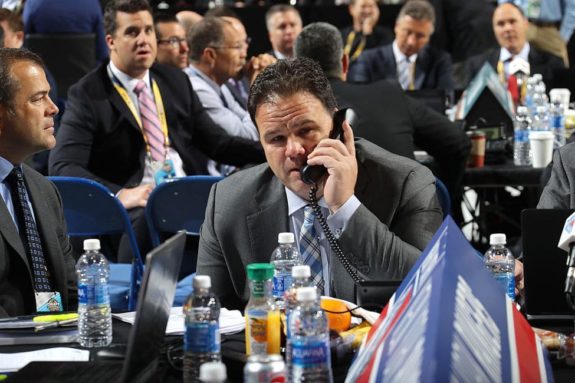
However, though most of the GM’s transactions have been hits, some of them haven’t worked out – and for others, could go either way in time.
Given the youth of this team, we’ll take a look at some of the biggest moves from the standpoint of how they were trending before the league’s shutdown.
Trending Up
Artemi Panarin Signing
Fans shouldn’t kid themselves – the Rangers’ rebuild wouldn’t look anything like it has this season without the July 1 free-agent signing of the Bread Man, the aforementioned veteran offseason pickup. Panarin wanted the Big Apple and got it, with Gorton and team president John Davidson getting their man despite having the third-largest contract offer – and he’s made that seven-year, $81.5 million deal look like a major bargain.
Related: New York Rangers and 99 – When Gretzky Hung Them Up
With 32 goals and 63 assists, Panarin was a lock to reach the 100-point mark for the first time in his career had the Rangers played a full season. His dynamic offensive play and unbridled enthusiasm make him the Rangers’ easy MVP, whether the season resumes or not. This could prove to be among the best free-agent signings in team history.
Mika Zibanejad Trade
Gorton’s acquisition of the sixth-overall pick in 2011 (along with a second-rounder in 2018) from the Ottawa Senators in a complete heist of a trade for Derick Brassard and a seventh-rounder in July 2016 appears to have netted the Rangers one of the best players in that draft. Zibanejad had grown into a No. 1 center by last season when he recorded 30 goals and 44 assists and has a stunning 41 goals and 34 assists in 57 games in this campaign.
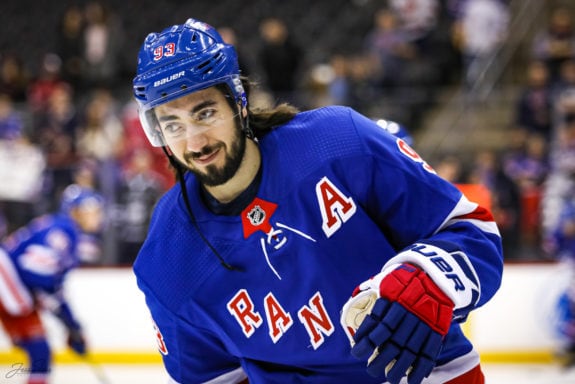
Zibanejad has totaled 233 points in 267 games with the Rangers, and might just be on track to be the team’s next captain. Signing the just-turned 27-year-old to what is now an absurdly team-friendly deal, five years and $26.75 million, in July 2017 only burnishes the GM’s reputation on this trade. Nice work, Jeff.
Adam Fox Trade
The highly-rated defense prospect out of Harvard was drafted by the Calgary Flames in the third round in 2016 and had his rights traded to the Carolina Hurricanes in 2018, but didn’t sign with either team. Fox could have become a free agent this summer and rumors swirled that the Long Island native would only sign with the Rangers at that point. Gorton, though, was unwilling to wait and chance Fox inking a deal with someone else, sending what became a pair of second-round picks to Carolina last April for the rights to Fox.
No one’s questioning that decision now. The 22-year-old right-handed shot recorded eight goals, 34 assists and a plus-22 rating in 70 games as a rookie, and his hockey sense and heady play gave him the look of a future top-pair defenseman – if he wasn’t already, teaming with Ryan Lindgren on what was the Blueshirts’ most effective pair when play paused last month.
Rick Nash Deal
Speaking of Lindgren, Gorton’s trading of Nash to the Boston Bruins before the February 2018 deadline – the club’s first major deal after announcing its intention to rebuild in a letter to fans earlier that month – looks like a winner so far. Lindgren, a throwback defender who was a second-round pick of the Bruins in 2016, could be a long-term keeper on Fox’s left side. The first-round pick in the deal, 26th overall in 2018, allowed the Rangers to move up four spots to draft highly regarded defensive prospect, K’Andre Miller.
Gorton further scored in this trade with throw-in forward Ryan Spooner, who he later flipped to the Edmonton Oilers for center Ryan Strome, who revived his career this season as the center on Panarin’s line.
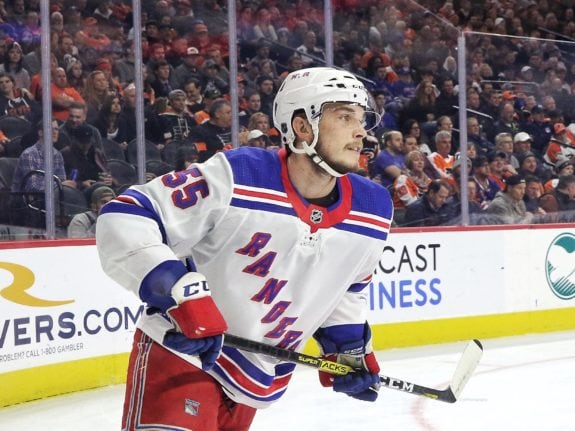
Strome, drafted one spot before Zibanejad in 2011, has 59 points in 70 games in 2019-20. Spooner was waived by Edmonton in Jan. 2019, picked up, and then bought out by the Vancouver Canucks that June, and ended up in the KHL this season.
Nash, then a pending unrestricted free agent, had minimal impact with Boston, with six points in 11 regular-season games and five points in 12 playoff contests in 2018 before retiring.
Related: Henrik Lundqvist – By the Number for No. 30
The deal doesn’t make up for the Rangers’ trade of Rick Middleton to the Bruins for Ken Hodge in 1976 – likely the worst trade in franchise history – but maybe it helps at least a little bit.
Tony DeAngelo Acquisition
This one is part of a trade that delivered very well and very bad for Rangers (more on that later). On June 23, 2017, Gorton sent center Derek Stepan and goaltender Antti Raanta to the Arizona Coyotes for the seventh-overall pick in that year’s draft and DeAngelo.
The draft choice yielded center Lias Andersson, who to this point has represented one of Gorton’s bigger failures as Rangers GM – but DeAngelo has singlehandedly rescued the deal. After struggling with the maturity and behavioral issues that plagued his career early on, DeAngelo has developed into an offensive force from the blue line, totaling 15 goals, 38 assists and a plus-12 rating in 68 games in 2019-20.
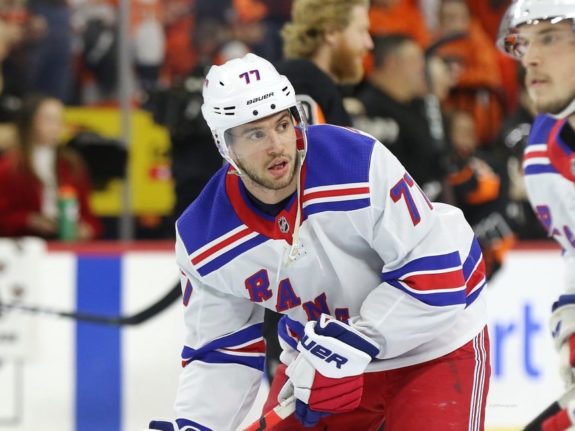
It’s possible DeAngelo, a throw-in to the deal with the Coyotes, might be traded this offseason with his salary set to jump as a restricted free agent, but he won’t be moved without the Blueshirts receiving a major asset or two in return.
Trending Sideways
Jacob Trouba Acquisition
There were signs the big right-side defender, acquired from the Winnipeg Jets for a first-round pick and defenseman Neal Pionk last summer, was starting to trend upward just before the pandemic pause. Trouba was more physical and confident with the puck in those final two weeks after a season of major adjustment and inconsistent play. He admittedly struggled with the move to the big city, as well as a new system and role as the anointed No. 1 D-man on the right side after being shielded from that responsibility with the Jets.
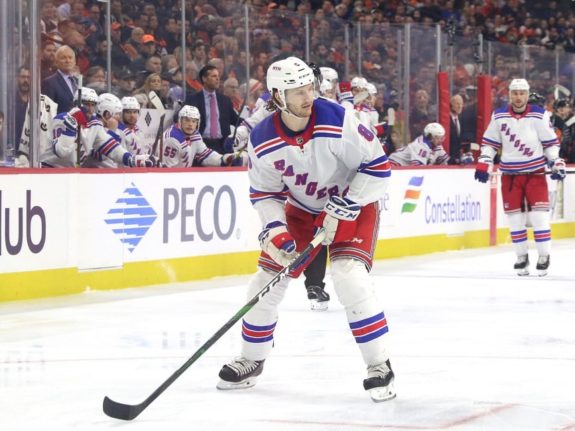
Trouba wasn’t a disappointment, but he didn’t match the hype from what was seen as a steal of a deal in his first season on Broadway. The potential loss of the remainder of this season means the Rangers will have also lost valuable evaluation time for the 26-year-old. Trouba, signed to a seven-year, $56 million contract after being obtained, gains no-movement protection this offseason. Though the Rangers probably won’t explore a trade for him, Trouba’s uneven season could cause them to at least consider doing so.
Ryan McDonagh/J.T. Miller Trade
Though there’s still time, Gorton might be a little nervous that the flat trajectory of this deal could end up going off a cliff. A day after the Nash trade with Boston, Gorton sent McDonagh, the Blueshirts’ captain, and Miller to the Tampa Bay Lightning for prospects Libor Hajek, Brett Howden, first- and second-round picks and Vladislav Namestnikov before the deadline later that month.
The returns so far aren’t good for the Rangers. Hajek, a defenseman who was the linchpin of the deal, has experienced plenty of growing pains and was struggling after being demoted to the AHL at the time of the shutdown. Howden hasn’t shown nearly enough to be seen as a long-term keeper, while Namestnikov was traded to Ottawa early this season.
The second-rounder in 2019 was used on center Karl Henriksson. The Rangers took defenseman Nils Lundkvist with the first-rounder in 2018, and his rapid development this season has the Blueshirts looking to get him signed and into training camp this summer – as they might need him to salvage this trade for them.
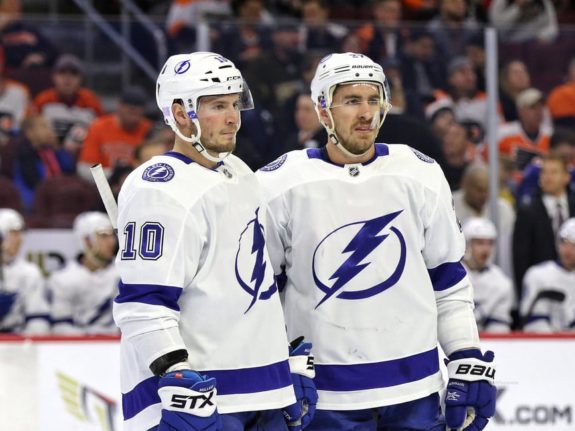
McDonagh enjoyed a strong first full season with the Lightning after signing a long-term deal with them but was hindered by injury this season. Miller, the 27-year-old power forward, was dealt to the Canucks during the 2019 draft and recorded 27 goals and 45 assists in 69 games in his first campaign there. This trade isn’t looking great for Gorton right now.
Drafting Vitali Kravtsov
The Rangers’ selection of the Russian forward with the ninth-overall pick in 2018 raised eyebrows at the time, with a number of more highly-rated prospects still on the board. The ambitious choice hasn’t delivered results so far. Kravtsov struggled with the adjustment to North American hockey and life, failing to make the team out of camp and embarking on a jaunt through the AHL, KHL and back this season.
Related: Top 10 Undersized NHL Players
He was starting to play better at Hartford before the pause, and the Rangers hope that time and maturity will allow the offensively talented 20-year-old to eventually find his game.
Chris Kreider Contract Extension
This gets mentioned simply because it’s too early to tell whether it was the right move. The Rangers locking up their homegrown power forward long-term on the day of this year’s trade deadline appeared to be the correct choice, but seven years at $6.5 million per for him certainly has the potential to backfire.
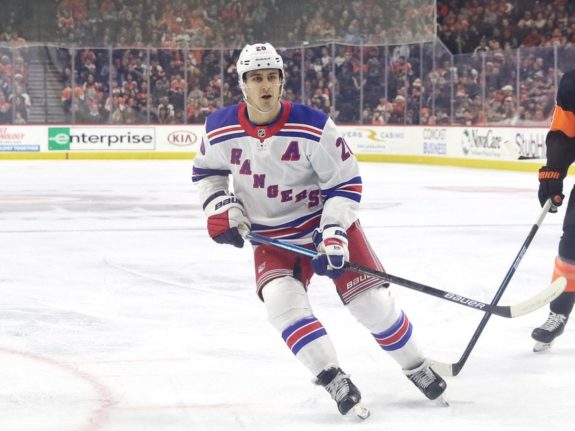
Kreider has never reached 30 goals in a season, and his streaky nature and penchant for long disappearing acts could only become more pronounced as he moves into his 30s – which happens late next season.
Kevin Shattenkirk Buyout
This decision was all but required due to salary cap constraints, and it allowed the Rangers to afford the signing of Panarin, in part. Still, Shattenkirk responded to the unceremonious end of his homecoming by signing a one-year deal with the Lightning and, finally healthy, putting up 34 points and a career-high plus-22 rating. His impact on the Rangers will remain prominent next season when the buyout will result in more than $6 million in dead money on their cap.
It’s not as if the Blueshirts would reverse this if it was possible, given that Shattenkirk’s departure opened up the right side of the defense for Trouba, Fox and DeAngelo (or perhaps Lundkvist) to carry them into the future. Still, if Shattenkirk starts to excel again after leaving the Rangers, it will provide a constant reminder of what they gave up. Shatty’s exit was probably necessary, but messy. The effects will last for at least two more seasons, whether through the dead money from the buyout, Shattenkirk extending his resurgence, or both.
Trending Down
Trading Ryan Graves
Gorton hasn’t had a lot of truly bad moments in his nearly five years as Rangers GM, but this was one of them. The Rangers drafted the 6-foot-5, 220-pound blueliner in the fourth round in 2013 and for whatever reason, weren’t able to identify him as a serious talent. Graves was and is that, however, which he proved emphatically after being handed over to the Colorado Avalanche for defenseman Chris Bigras on Feb. 26, 2018 – the same day as the McDonagh-Miller trade with Tampa Bay, with those two moves having the potential to make that a really bad date on the Rangers’ calendar for years to come.
Graves scored his first NHL goal against the Rangers in Jan. 2019 and really stuck it to them this season, when he led the league with a plus-40 rating in 69 games, with nine goals, 17 assists, 150 blocked shots and 112 hits. (from ‘How Avalanche’s Ryan Graves emerged as NHL plus/minus leader,’ Denver Post, 12/10/2019) Instead of possibly manning the left side opposite Trouba to form an intimidating top defense pair, Graves looks like a cornerstone on a talented young Avalanche squad.
Graves put up good numbers with the Wolf Pack and made the 2016 AHL All-Star Game. It’s difficult to understand why Gorton and the Rangers didn’t see how a big, strong, mobile defenseman who plays with an edge and possesses offensive ability wouldn’t bring any value to their rebuilding efforts. Not good.
Drafting Lias Andersson
Taking the Swedish center with the No. 7 pick in 2017 was the source of plenty of head-scratching at the time, with essentially no other personnel execs around the league seeing the requisite skill level for Andersson to be selected that high. That seems to have been proven true, as Andersson has generally impressed no one in totaling three goals, six assists and a minus-20 rating in 66 NHL games.
Of course, this situation turned out to be so much more for the Rangers than just a question of talent: Sent to the AHL in November after 17 unremarkable games with the Blueshirts this season, Andersson quit the Wolf Pack not long after and requested a trade. In January, the Rangers loaned Andersson to HV71 of the Swedish Hockey League, and team president John Davidson has made contact with the 21-year-old in an attempt to restart a dialogue, but the obstacles to Andersson ever making an impact on Broadway seem significant.
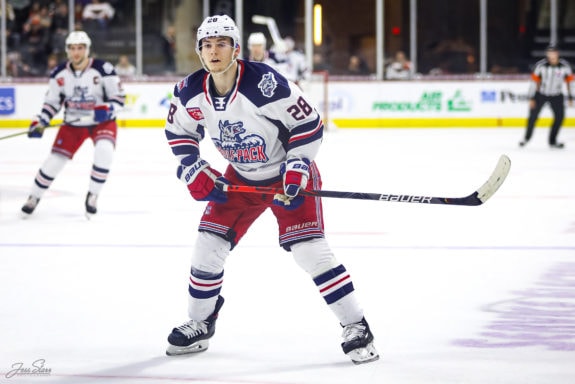
The immaturity and poor attitude were all the more surprising given the rumors that the Rangers might have felt Andersson’s makeup was conducive to him making the big club more quickly than other prospects in his draft class. It seems clear that Gorton and his scouting staff missed significant shortcomings – both mental and physical – with the player, whose high selection evokes memories of a myriad of past Rangers’ draft disasters. The club also may not have given Andersson much of a chance to succeed, adding to the disheartening tone surrounding the situation.
Related: 5 Forgotten New York Islanders
The inclusion of DeAngelo in the trade with Arizona prevented it from being a washout, but this is unlikely to be remembered as anything close to Gorton’s finest hour.
Re-signing Brendan Smith
The veteran defenseman has managed to resurrect his career by rededicating himself and adding versatility to his game over the past two seasons, but there’s little question Smith’s four-year, $17.4 million deal signed after the 2016-17 season is one Gorton would like back. Smith followed up an impressive 2017 postseason effort after being acquired by the Rangers from the Red Wings with an ugly 2017-18 campaign – the first of his new contract – with his game and approach unfocused before getting waived and sent to the AHL in Feb. 2018.
The low point might have come with the Wolf Pack, with Smith breaking his hand in a fight with teammate Vinni Lettieri, ending his season.
Smith came to training camp in better shape the next season and embraced coach David Quinn’s use of him at forward, where he was effective in a grinder’s role. That continued into this season, and Smith moved back to defense full-time and was mostly effective after the trade of Brady Skjei at the February deadline.
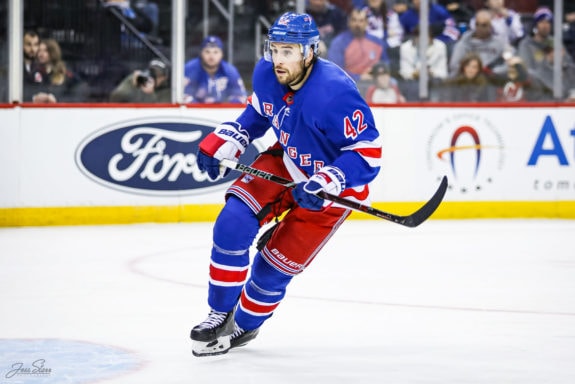
The choice to keep Smith after his impressive playoff performance three years ago seemed sound at the time, but the Rangers’ front office might pop open a bottle of champagne when Smith’s deal expires after next season.
Winning the Jimmy Vesey Sweepstakes
The Harvard winger was a highly sought-after free agent following his decision not to sign with the Nashville Predators, who drafted him in 2012, or the Buffalo Sabres, who acquired his rights in June 2016. More than 10 teams pursued him before the Rangers won out in August of that year, but the Blueshirts went largely unrewarded for their good fortune.
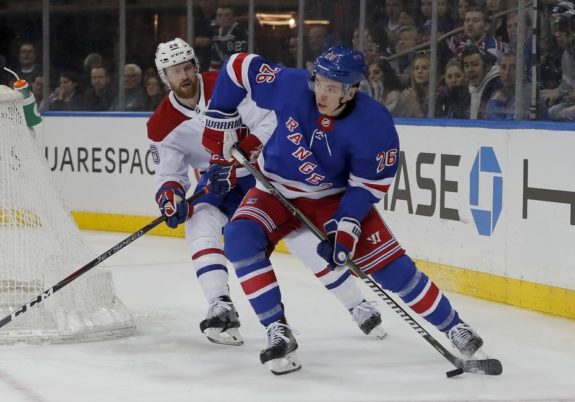
Vesey has shown some promise, with 50 goals and 40 assists in 240 career games, but he appears to be a bottom-six forward at best. The Rangers sent him to the Sabres for a third-round draft pick July 1, and he put up nine goals, 11 assists and a plus-12 rating in 64 games this season. It’s not as if Gorton risked anything here, but given the amount of interest surrounding the player, Vesey’s brief and forgettable career with the Rangers stands out as one of the uncommon missteps in Gorton’s largely impressive procurement of young talent amidst the rebuild.